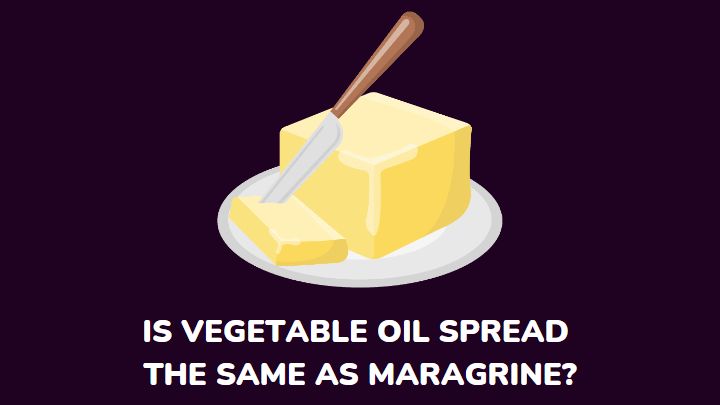Are you curious, is vegetable oil spread the same as margarine? Well, the answer is no. While they both look so much alike, vegetable oil spread has less fat compared to margarine.
Margarine and vegetable oil spread are typically made from plant oils. However, what differentiates them is that margarine contains 80% or more fat (similar to butter), unlike vegetable oil spread which has less.
This article will explain their uses, differences, nutritional benefits, and other relevant information you should know about vegetable oil spread and margarine. Let’s dive right in.
Vegetable oil spread
Vegetable oil spread is a type of oil derived from the seeds or nuts of vegetable plants, such as corn, soybeans, peanuts, safflower seeds, sunflower seeds, and rape seeds.
This oil is transformed into a spreadable form of margarine to replace butter.
Furthermore, vegetable oil spread can be used to top toast, bread, muffins, crackers, and other foods or add flavor.
However, vegetable oil spread should only be used for baking meals with a substantial quantity of moisture, such as some pasta and cheese recipes.
Composition of vegetable oil spread
| Magnesium | 0.40% |
| Fat | 335.23% |
| Calcium | 0.84% |
| Sugar | 2.42% |
| Phosphorus | 3.14% |
| Potassium | 0.49% |
| Sodium | 22.78% |
| Zinc | 0.64% |
| Copper | 0.43% |
| Manganese | 0.25% |
| Vitamin A | 84.22% |
Uses of vegetable oil spread
Vegetable oil spread has a lot of uses. Due to their natural state as liquids at room temperature, it is often used to make baked products stable and keep them fresh.
Also, vegetable oil spread improves the taste and texture of your baked goods.
Vegetable oil spreads are also stable and oxidation resistant, making them ideal for different cooking activities, such as baking, frying, etc.
Downsides of vegetable oil spread
Vegetable oil spreads have a couple of detriments to the body.
These downsides include impaired blood sugar control and increased chronic body inflammation, which could lead to diabetes and cancer and cause health problems.
What is margarine?
Margarine is a food product generally composed of one or more vegetable or animal fats or oils, butter, salt, flavoring agents, yellow food colors, emulsifiers, preservatives, and vitamins A and D.
It contains aqueous liquid milk products, which can be used as a spread and in cooking. Nutritionally, margarine includes a significant amount of calories.
Other types of margarine include soft margarine, whipped margarine, liquid margarine, reduced-fat margarine, and fat-free margarine.
Composition of margarine
| Protein | 0.3g |
| Calcium | 7mg |
| Iron | 0.12mg |
| Magnesium | 2mg |
| Manganese | 0.014 mg |
| Phosphorus | 10 mg |
| Potassium | 46 mg |
| Sodium | 700 mg |
| Zinc | 0.06 mg |
Uses of margarine
Other than its taste, margarine has many nutritional benefits. It contains vitamins A, D, and E and essential body fats. So, it’s safe enough to include it in your recipe.
You can use it for baking your snacks (cookies, biscuits, etc.), spicing up your fish, or making pancakes, and it can be added to your tomato sauce.
Downsides of margarine
While margarine contains beneficial body nutrients, it contains trans fat, linked to a higher risk of heart disease and other chronic health problems.
Also, margarine contains polyunsaturated omega-6 fatty acids, which may increase inflammation and harm the body.
FAQS
Can you bake with margarine?
Yes, you can. Since margarine includes 80% vegetable oil, you can use it repeatedly and expect the same results.
Can you freeze margarine?
Yes, you can. Freezing margarine can help preserve it for six months.
How long does margarine last?
Unopened margarine lasts around 2-3 months, while opened margarine lasts about 4-5 months.
What is the difference between butter and margarine?
The difference between the products is in the type of fat, butter is made from cream, and margarine is made from vegetable oil.
Which margarine is the healthiest?
The healthiest type of margarine is the softer tub and squeeze tube type because they contain less saturated fat than other types of margarine.
Conclusion
While vegetable oil spreads are often called margarine, they are both different. Vegetable oil spread contains 80% more fat than margarine.
Finally, margarine is made of vegetable oils derived from soy, cottonseed, and corn, while vegetable oil spreads are made by emulsifying liquid and polyunsaturated vegetable oils with water.
Thank you for reading.
Read other comparison articles on Millenora.
